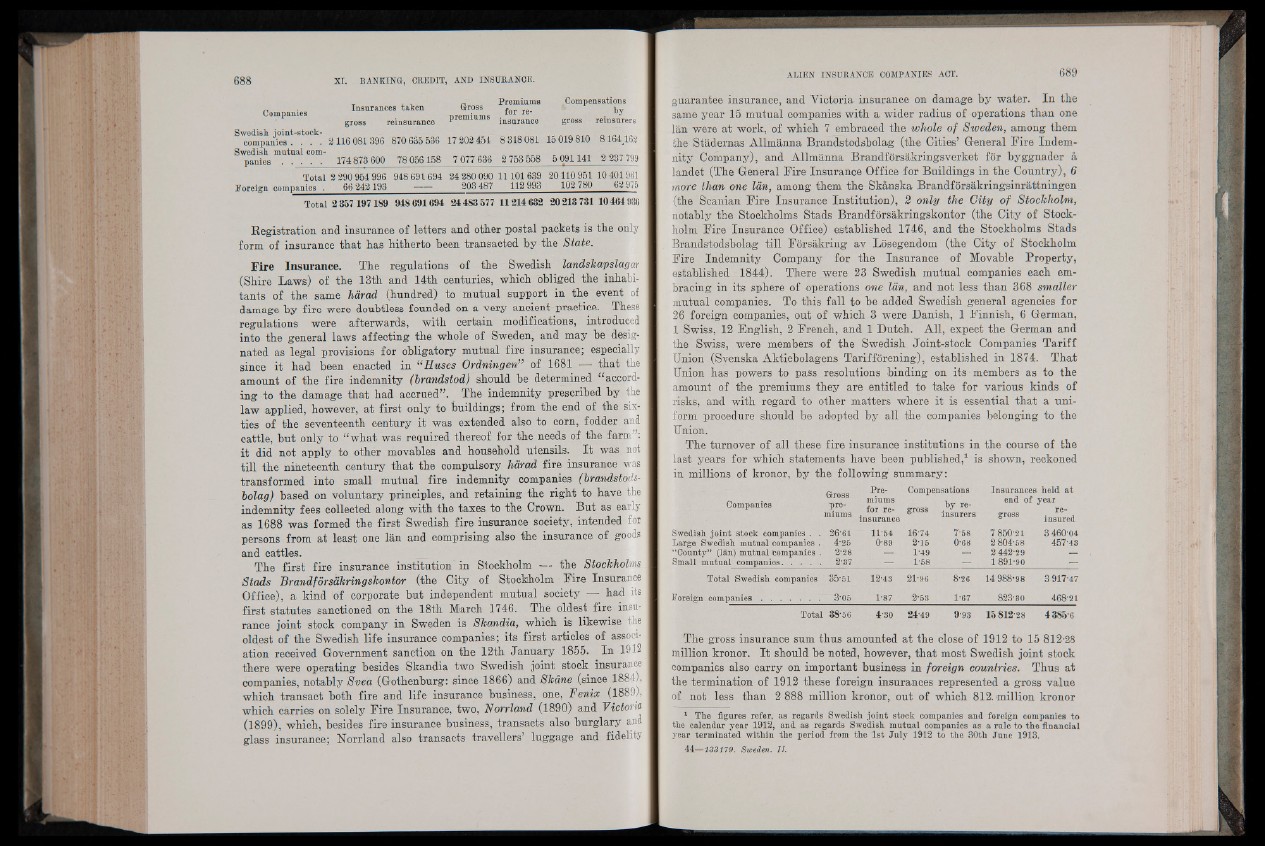
_ Premiums .Compensations
Companies Insurances taken Gross for re. I by
gross reinsurance premiums ¡nsurance gr08s reinsurers
STompani°esI1!"StOCk! 2116 0S1396 870 635536 17 202 454 8 318 081 15019 810 8164162
Swedish mutual com- ^ . WÊg___
panies . . . . . 174 873 600 78 056158 7 077 636 2 753 558 5 0.91141 2 237 799
Total 2 290 954 996 948 691 694 24 280 090 11 101 639 20110 951 10401 961
Foreign companies . 66 242 193 ----- 203 487 112 993___ 102 780___ 02 975
Total 2357197189 948691694 24483577 11214632 20213 731 10464936
Registration and insurance of letters and other postal packets is the only
form of insurance that has hitherto been transacted by the State.
Fire Insurance. The régulations of the Swedish landskapslagar
(Shire Laws) of the 13th and 14th centuries, which obliged the inhabitants
of the same hdrad (hundred) to mutual support in the event of
damage by fire were doubtless founded on a very ancient practice. These
regulations were afterwards, with certain modifications, introduced
into the general laws affecting the whole of Sweden, and may be designated
as legal provisions for obligatory mutual fire insurance; especially
since it had been enacted in “Huses Ordningen” of 1681 — that the
amount of the fire indemnity (brandstod) should be determined “ according
to the damage that had accrued”. The indemnity prescribed by the
law applied, however, at first only to buildings; from the end of the sixties
of the seventeenth century it was extended also to corn, fodder and
cattle, but only to “what was required thereof for the needs of the farm”:
it did not apply to other movables and household utensils. I t was not
till the nineteenth century that the compulsory hârad fire insurance was
transformed into small mutual fire indemnity companies (brandstods-
bolag) based on voluntary principles, and retaining the right to have the
indemnity fees collected along with the taxes to the Crown. But as early
as 1688 was formed the first Swedish fire insurance society, intended for
persons from at least one lan and comprising also the insurance of goods
and cattles.
The first fire insurance institution in Stockholm — the Stockholm
Stads Brandfôrsâkringskontor (the City of Stockholm Fire Insurance
Office), a kind of corporate but independent mutual Society —■ had its
first statutes sanctioned on the 18th March 1746. Thé oldest fire insurance
joint stock company in Sweden is Skandia, which is likewise the
oldest of the Swedish life insurance companies; its first articles of association
received Government sanction on the 12th January 1855. In 1912
there were operating besides Skandia two Swedish joint stock insurance
companies, notably Svea (Gothenburg: since 1866) and Skâne (since 1884),
which transact both fire and life insurance business, one, Fenix (1889),
which carries on solely Fire Insurance, two, Norrland (1890) and Victoria
(1899), which, besides fire insurance business, transacts also burglary and
glass insurance; Norrland also transacts travellers’ luggage and fidelity
guarantee insurance, and Victoria insurance on damage by water. In the
same year 15 mutual companies with a wider radius of operations than one
lan were at work, of which 7 embraced the whole of Sweden, among them
she Stadernas Allmanna Brandstodsbolag (the Cities’ General Fire Indemnity
Company), and Allmanna Brandforsakringsverket for byggnader a
landet (The General Fire Insurance Office for Buildings in the Country), 6
more than one lan, among them the Skanska Brandforsakringsinrattningen
(the Scanian Fire Insurance Institution), 2 only the City of Stockholm,
notably the Stockholms Stads Brandforsakringskontor (the City of Stockholm
Fire Insurance Office) established 1746, and the Stockholms Stads
Brandstodsbolag till Forsakring av Losegendom (the City of Stockholm
Fire Indemnity Company for the Insurance of Movable Property,
established 1844). There were 23 Swedish mutual companies each embracing
in its sphere of operations one lan, and not less than 368 smaller
mutual companies. To this fall to be added Swedish general agencies for
26 foreign companies, out of which 3 were Danish, 1 Finnish, 6 German,
1 Swiss, 12 English, 2 French, and 1 Dutch. All, expect the German and
the Swiss, were members of the Swedish Joint-stock Companies Tariff
Union (Svenska Aktiebolagens Tarifforening), established in 1874. That
Union has powers to pass resolutions binding on its members as to the
amount of the premiums they are entitled to take for various kinds of
risks, and. with regard to other matters where it is essential that a uniform
procedure should be adopted by all the companies belonging to the
Union.
The turnover of all these fire insurance institutions in the course of the
last years for which statements have been published,1 is shown, reckoned
in millions of kronor, by the following summary:
Gross Pre_ Compensations Insurances held at
r. .Compani es pre- m„ iums ■b. y re- end of Jyear * mm. ms I for re-I g° r oss i. nsJ urers gross . re- insurance ° insured
Swedish joint stock companies . . 26*61 11*54 16*74 7*58 7850*21 3 460*04
Large Swedish mutual companies . 4*25 0*89 2*15 0*68 2 804*58 457*43
“County” (lan) mutual Companies . 2*28 — 1*49 — 2 442*29 —
Small mutual companies________ 2*37_______— 1*58 — 1891*90________ —
Total Swedish companies 35*51 12*43 21*96 8*26 14 988*98 3 917*47
Foreign comp a n ie s 3*05 1*87 2*53 1*67 823*30_____468*21
Total 38*56 4*30 24*49 9*93 15812*28 4385*6
The gross insurance sum thus amounted at the close of 1912 to 15 812*28
million kronor. It should be noted, however, that most Swedish joint stock
companies also carry on important business in foreign countries. Thus at
the termination of 1912 these foreign insurances represented a gross value
of not less than 2 888 million kronor, out of which 812. million kronor
1 The figures refer, as regards Swedish joint stock companies and foreign companies to
the calendar year 1912, and as regards Swedish mutual companies as a rule to the financial
year terminated within the period from the 1st July 1912 to the 30th June 1913.
44— 133179. Sweden. 11.